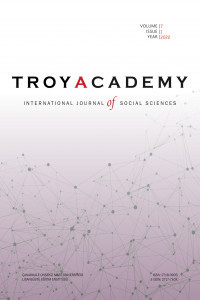Bağlanmanın Doğal Sonucu: Ayrılma Kaygısı
Ayrılma kaygısı, bağlanma, çocuklarda kaygı bozuklukları
Natural Result of Attachment: Separation Anxiety
Separation anxiety, attachment, anxiety disorders in children,
___
- Ainswonh, M. D. S. (1979). Infant-mother attachment. American Psychologist, 34 (10), 932-937.
- Ainsworth, M. D. S., ve Bell, S. M. (1970). Attachment, exploration, and separation: Illustrated by the behavior of one-year-olds in a strange situation. Child Development, 41 (1), 49-67.
- Ainsworth, M. D. S., Blehar, M. C., Waters, E. ve Wall, S. (2014). Patterns of Attachment: A psychological study of the strange situation. NY: Psychology Press.
- American Psychiatric Association. (2013). Diagnostic and statistical manual of mental disorders (5th edition.). Washington: Amerikan Psychiatric Publishing.
- Bahalı, K., Tahiroğlu, A. Y., Avcı, A. (2009). Okul reddi olan çocuk ve ergenlerin klinik özellikleri. Anadolu Psikiyatri Dergisi, 10 (1), 310-317.
- Bar-Haim, Y., Dan, O., Eshel, Y. ve Sagi-Schwartz, A. (2007). Predicting children’s anxiety from early attachment relationships. Journal of Anxiety Disorders, 21 (1), 1061-1068.
- Bolwby, J. (1982). Attachment and loss: Attachment (2nd edition.). NY: Basic Books.
- Dallaire, D. H. ve Weinraub, M. (2005). Predicting children’s separation anxiety at age 6: The countributions of infant-mother attachment security, maternal sensitivity, and maternal separation anxiety. Attachment & Human Development, 7 (4), 393-408.
- Doobay, A. F. (2008). School refusal behavior associated with separation anxiety disorder: A cognitivebehavioral approach to treatment. Psychology in the Schools, 45 (4), 261-272.
- Erikson, E. (1977). Childhood and society (Revised ed.). London: Paladin Grafton Books.
- Eysenck, S. B. G., Eysenck, H. J. ve Barret, P. (1985). A revised version of the psychoticism scale. Personality and Individual Differences 6 (1), 21-29.
- Francis, G., Last, C. G. ve Strauss, C. C. (1987). Expression of separation anxiety disorder: The roles of age and gender. Child Psychiatry and Human Development, 18 (2), 82-89.
- Freud, S. (1994). Psikanaliz üzerine (7. Baskı). (A. A. Öneş, Çev.). İstanbul: Say Yayınları. (Orijinal çalışma basım tarihi 1910.)
- Göker, Z., Güney, E., Dinç, G., Hekim, Ö., Üneri, Ö. Ş. (2015). Çocuk ve ergenlerde anksiyete ile ilişkili bozuklukların klinik ve demografik özellikleri: Bir yıllık kesitsel bir örneklem. Klinik Psikiyatri, 18 (1), 7-14.
- Harlow, H. F. (1958). The nature of love. American Psychologist, 13 (12), 673-685.
- Hock, E., Eberly, M., Bartle-Haring, S., Ellwanger, P., Widaman, K. F. (2001). Separation anxiety in Parents of Adolescents: Theoretical Significance and Scale Development. Child Development, 72 (1), 284-298.
- Irmak, M. Y., Irmak, A., Murat, D., Demir, N. Ü. (2016). Ayrılık anksiyetesi bozukluğu ile ilişkili okul reddi; bir ergen olgu sunumu. Journal of Contemporary Medicine, 6 (4), 357-360.
- İkiz, F. E., Otlu, B. M., Vural, D. E. (2016). Erken çocukluk döneminde görülen problem davranışlar: Öğretmenlerin değerlendirmesi. Mehmet Akif Ersoy Üniversitesi Sosyal Bilimler Enstitüsü Dergisi, 8 (17), 216-229.
- Kesebir, S., Kavzoğlu, S. ve Üstündağ, M. F. (2011). Bağlanma ve psikopatoloji. Psikiyatride Güncel Yaklaşımlar, 3 (2), 321-342. Masi, G., Mucci, M. ve Millepiedi, S. (2001). Separation anxiety disorder in children and adolescents. CNS drugs, 15 (2), 93-104. Morrissey, M. (2013). EMDR as an integrative therapeutic approach for the treatment of separation anxiety disorder. Journal of EMDR Practice and Research, 7 (4), 200-207.
- Muris, P. ve Meesters, C. (2002). Attachment, behavioral inhibition, and anxiety disorders symptoms in normal adolescents. Journal of Psychopathology and Behavioral Assessment, 24 (2), 97-106.
- Muris, P., Meesters, C., Melick, M. V. ve Zwambag, L. (2001). Self-reported attachment style, attachment quality, and symptoms of anxiety and depression in young adolescents. Personality and Individual Differences, 30 (1), 809-818.
- Phelps, L., Cox, D. ve Bajorek, E. (1992). School phobia and separation anxiety: Diagnostic and treatment comparisons. Psychology in the Schools, 29 (4), 384-394.
- Sümer, N., Sayıl, M. ve Berument, S. K. (2016). Anne duyarlılığı ve çocuklarda bağlanma (1. Baskı). İstanbul: Koç Üniversitesi Yayınları.
- Türkbay, T. ve Söhmen, T. (2001). Ayrılma kaygısı bozukluğunda bireysel ve ailesel etmenler. Çocuk ve Gençlik Ruh Sağlığı Dergisi, 8 (1), 77-84.
- Warren, S. L., Huston, L., Egeland, B. ve Sroufe, L. A. (1997). Child and adolescent anxiety disorders and early attachment. American Academy of Child and Adolescent Psychiatry, 36 (5), 637-644.
- Wright, J. C., Binney, V. ve Smith, P. K. (1995). Security of attachment in 8-12-year-olds: A revised version of the separation anxiety test, its psychometric properties and clinical interpretation. Child Psychology and Psychiatry, 36 (5), 757-774.
- ISSN: 2718-0905
- Yayın Aralığı: Yılda 3 Sayı
- Başlangıç: 2016
- Yayıncı: Çanakkale Onsekiz Mart Üniversitesi
Dış Politika Analizinde Karar Verme Süreci ve Karar Verme Modelleri
Bağlanmanın Doğal Sonucu: Ayrılma Kaygısı
Sovyetler Birliği’nde Komünist İdeolojinin Eğitime Yansımaları: 1920’li ve 1930’lu Yıllar
Tabae Roma Dönemi Kırmızı Astarlı Seramikleri
Geçmişi Yeniden Düşünmek: Şehir Devletler
Türkiye Ekonomisinde Finansal ve Ticari Açıklık Çevresel Kalite İlişkisi: Ampirik Uygulama
Elif MUDAM, Feyza BALAN, Barış ALBAYRAK
Türk Hamamlarında Hijyen ve Sanitasyonun Turist Sağliği Açısından Ele Alınması: Antalya İli Örneği
